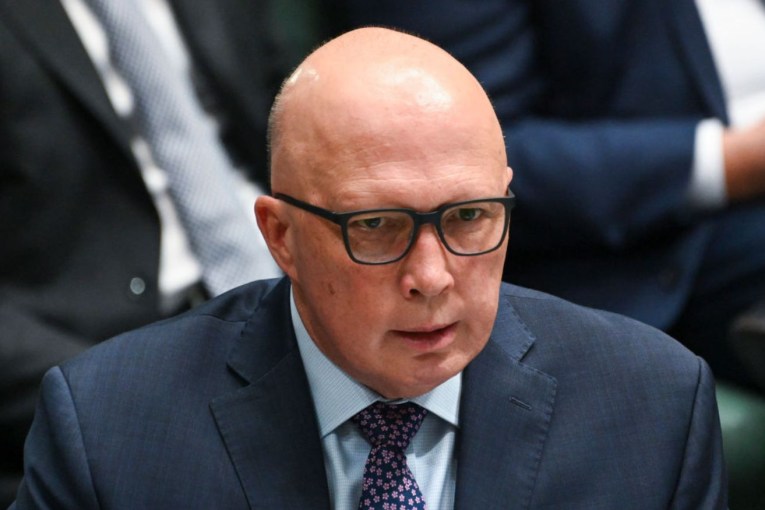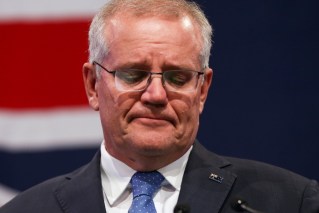Alan Kohler: Paying for AUKUS? Spending like Europe means taxing like Europe


Before the next election, Treasurer Jim Chalmers must find a way to credibly restore a balanced budget, writes Alan Kohler. Photo: AAP/TND
Scott Morrison says that to accommodate the AUKUS submarines deal, Australia’s defence budget will need to increase to 2.5 per cent of GDP, and there’s not much doubt he’s right.
That’s an extra $10 billion or so per year, on top of a structural deficit of $50 billion a year, already rising to $70 billion. Make that $80 billion.
So where is the money coming from? Tax increase or spending cuts?
Alternatively, of course, we could relax and learn to love deficits and debt – like Japan and Europe.
The broader problem is that the cost of running Australia has gone up a lot in the past few years, and with the defence spending needed for today’s tense geopolitics it will go up some more.
In 2019, Treasury’s forecast for total government spending in 10 years time was 23.5 per cent of GDP. In March last year – the Coalition’s last budget – the 10-year forecast for payments was 26.5 per cent of GDP, and the latest forecast last October was 27.9 per cent.
That means in the past four years, the longer-term cost of running the Australian government has gone up $160 billion per year.
Treasury’s revenue forecasts are rising at the same clip, which is why the deficit is predicted to stay flat at roughly 2 per cent of GDP … forever. A deficit that’s flat as a percentage of GDP is rising in dollars – to $72 billion in 10 years’ time.
But years of running newspaper editorial budgets has taught me that cost forecasts are always more reliable than revenue forecasts, which are – let’s be honest – pure guesses.
But based on those revenue guesses, the government’s long-term budget repair task is $72 billion per year, plus AUKUS.
Daunting goal
Is that even doable? Judging by the hoo-hah over the measly $2 billion increase in taxation of superannuation, definitely not.
In the October budget, Treasury revealed its forecasts for the annual growth rates of seven big expenditure items, presumably to give us all a fright.
The average forecast growth of the seven was 7.6 per cent per annum, but considering that total government outlays have grown at a compound rate of 8.8 per cent a year over the past 50 years, those numbers were neither frightening nor surprising (although NDIS, at 13.8 per cent a year was a bit of a shocker).
It works out that Treasury is predicting that spending on everything else will grow by 3.6 per cent a year.
So to be clear: To keep the deficit down to $72 billion in a decade, the annual growth in spending on everything other than the seven big things will have to be cut by more than half, from 8.8 per cent to 3.6 per cent.
To balance the budget using only spending cuts would mean cutting that growth to an unlikely 2.5 per cent a year.
So, let’s turn to receipts, which are forecast by Treasury to be 26 per cent of GDP in 2032-33, implying growth of 5 per cent a year.
To reduce the deficit to zero in 10 years by only increasing revenue would require it to grow 5.7 per cent a year – not that much more, but a lot more than GDP or inflation.
And if we assume that tax is the same proportion of total receipts in 10 years as it is now (93 per cent), that means the federal tax-to-GDP ratio will be 25.9 per cent – blowing the 23.9 per cent “limit”.
Choose your poison
So what’s it to be? Tax increases or spending cuts? Treasury and Treasurer would no doubt say “a bit of both”, but is either possible?
Or could we forget about it and become as relaxed about budget deficits and debt as are Japan, Europe and, for that matter, the United States? (President Joe Biden just announced a $US6.8 trillion spending plan, on top of a deficit of $US1.38 trillion)
Focusing on Japan for a minute, 45 per cent of its government debt of 263 per cent of GDP is owned by the Bank of Japan, and the rest is owned by Japanese citizens happy with 0.5 per cent interest over 10 years (it was just 0.15 per cent last year and they were happy with that as well, apparently).
Australia’s government bonds are mainly owned by banks and super funds, not the public, and the yield they’re getting – and demand – is 3.6 per cent, which translates to a cost to the government of $13.8 billion this year, growing at 14.4 per cent per annum. In 10 years it’ll be $52 billion, the same as the age pension today.
The RBA owns 33 per cent of the $800 billion federal government bonds on issue, and more than 15 per cent of state government bonds and could theoretically go back to buying them, but it can’t be told what to do and is currently trying to get rid of its bonds.
That’s because the RBA now has a balance sheet of $619 billion in assets sitting on capital of $40 million, which makes Australia’s central bank more insolvent than Silicon Valley Bank – the worst capitalised bank in Australia by miles.
The RBA can print its own money so solvency is not an issue, but still … would you want to become director of a bank with liabilities that were 15,000 times its capital?
In reality, the RBA couldn’t do a Bank of Japan even if it wanted to unless it were to be recapitalised by the government – and the government hasn’t got the money for that.
And Australian bond investors are never going to accept Japanese-style interest rates, so endless deficits probably aren’t a goer.
All things considered then, before the next election Jim Chalmers and Treasury will have to find a way to credibly predict a return to a balanced budget in the distant future, and most of the work will have to be done by taxation – serious spending cuts are more or less impossible.
That means an extra $40 to $50 billion a year in extra “structural” tax receipts – that is, not resulting from cyclical commodity booms.
So, which taxes on what?
Increasing the GST to 15 per cent would just about do it. That’s about the average GST around the world, but it’s a savagely regressive tax, hardest on the poor, so not ideal, especially for a Labor government.
The Stage 3 tax cuts will cost $17.7 billion in the first year and $240 billion over 10 years, so that would go halfway towards plugging the gap, if the government could bring themselves to break that promise.
What about going further and raising the top income tax rate (from 45 per cent, which kicks in at $180,000)?
I delved into the ATO’s tax data and found that total taxable income above $180,000 is $186.2 billion, from which $69.1 billion is collected, or 37 per cent (the difference between that and 45 per cent is deductions and tax minimisation).
Getting the actual amount collected up to 45 per cent, or $83.8 billion – about $15 billion more – would require a top marginal rate of something like 60 per cent, which is what it was in 1985 before the Hawke government cut it to below 50 per cent.
But I doubt that a top marginal income tax rate above 50 per cent is possible any more. We’re so used to something with a ‘4’ in front of it that the very idea of something like 60 or 70 per cent is now greeted with a mixture incredulity and scorn.
Raising an extra $40 to $50 billion from income taxes is out of question, I’d say.
That leaves us with some form of wealth tax, levied on inheritance or land or just on wealth, as a few European countries do.
Yes, the screams would be loud and the opposition ferocious, but if we’re going to have government spending that looks more European, then we might have to have taxation that’s more European as well.
The average tax-to-GDP ratio in Europe is 37.8 per cent. In Australia, including state taxes, it’s 27.8 per cent.
The alternative is turning Japanese (I really think so).
Over to you Jim-san.
(I’m indebted to Chris Richardson for checking my sums)
Alan Kohler is founder of Eureka Report and finance presenter on ABC news. He writes twice a week for The New Daily
- Look out for Alan Kohler’s new series ‘The Innovators’ starting in TND next Monday.








